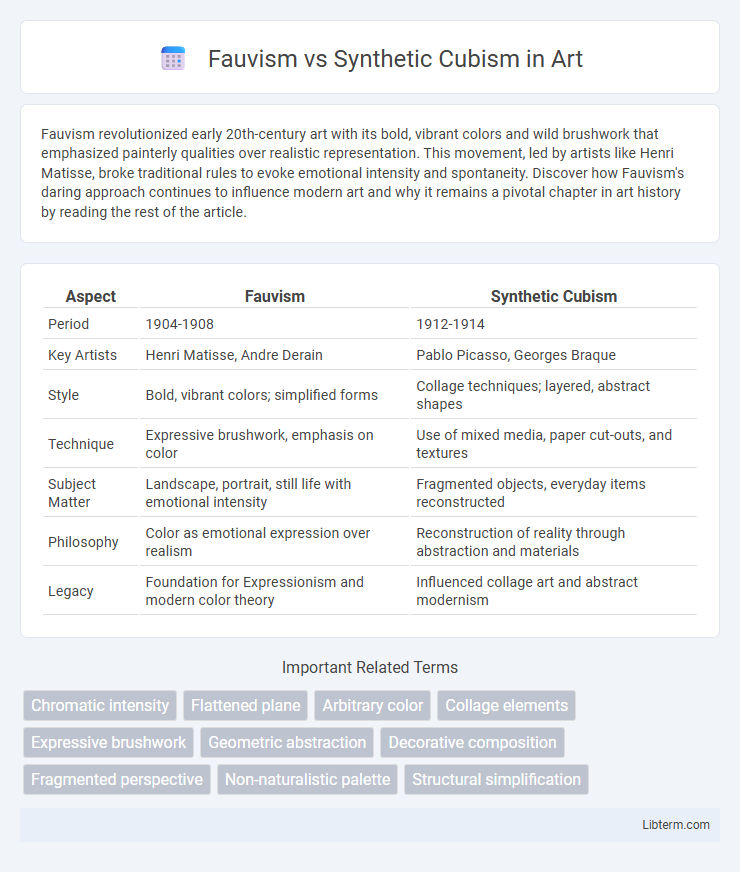Fauvism revolutionized early 20th-century art with its bold, vibrant colors and wild brushwork that emphasized painterly qualities over realistic representation. This movement, led by artists like Henri Matisse, broke traditional rules to evoke emotional intensity and spontaneity. Discover how Fauvism's daring approach continues to influence modern art and why it remains a pivotal chapter in art history by reading the rest of the article.
Table of Comparison
| Aspect | Fauvism | Synthetic Cubism |
|---|---|---|
| Period | 1904-1908 | 1912-1914 |
| Key Artists | Henri Matisse, Andre Derain | Pablo Picasso, Georges Braque |
| Style | Bold, vibrant colors; simplified forms | Collage techniques; layered, abstract shapes |
| Technique | Expressive brushwork, emphasis on color | Use of mixed media, paper cut-outs, and textures |
| Subject Matter | Landscape, portrait, still life with emotional intensity | Fragmented objects, everyday items reconstructed |
| Philosophy | Color as emotional expression over realism | Reconstruction of reality through abstraction and materials |
| Legacy | Foundation for Expressionism and modern color theory | Influenced collage art and abstract modernism |
Introduction to Fauvism and Synthetic Cubism
Fauvism, emerging in the early 20th century, is characterized by bold, vibrant colors and expressive brushwork that prioritize emotional impact over realistic representation. Synthetic Cubism, developed later by Picasso and Braque, emphasizes the construction of images using simplified shapes, collage elements, and varied textures to create fragmented yet cohesive forms. Both movements revolutionized modern art by challenging traditional perspectives and exploring innovative approaches to color, form, and composition.
Historical Context and Origins
Fauvism, emerging around 1904-1908 in France, is characterized by its bold use of vivid, non-naturalistic colors and spontaneous brushwork, pioneered by artists like Henri Matisse and Andre Derain as a reaction against Impressionism. Synthetic Cubism developed slightly later, between 1912 and 1914, primarily with Pablo Picasso and Georges Braque, emphasizing simplified shapes, brighter colors, and collage techniques, marking a shift from the fragmented forms of Analytical Cubism. Both movements originated during a period of rapid industrialization and artistic experimentation in early 20th-century Europe, reflecting a break with traditional representation and explorations of new visual languages.
Key Artists and Influencers
Fauvism, led by Henri Matisse and Andre Derain, emphasized bold color and simplified forms, revolutionizing modern art with expressive brushwork and vivid palettes. Synthetic Cubism, pioneered by Pablo Picasso and Georges Braque, introduced collage elements and flattened perspectives, focusing on geometric abstraction and reconstruction of subjects. Both movements significantly influenced 20th-century art, shaping developments in abstraction and visual expression.
Defining Characteristics of Fauvism
Fauvism is defined by its vivid, non-naturalistic color palette and aggressive brushwork, emphasizing painterly qualities over realistic representation. Artists like Henri Matisse employed bold colors to evoke emotional responses, often simplifying forms into flat, vibrant areas. In contrast to Synthetic Cubism's fragmented geometric shapes and collage elements, Fauvism celebrates expressive color and swift, spontaneous strokes as its core characteristics.
Defining Characteristics of Synthetic Cubism
Synthetic Cubism is characterized by simplified shapes, vibrant colors, and the use of mixed media such as collage elements, contrasting Fauvism's emphasis on wild brushwork and intense, non-naturalistic colors. It emphasizes two-dimensionality and the reconstruction of objects through geometric forms and overlapping planes, creating fragmented perspectives. Unlike Fauvism's expressive color and form, Synthetic Cubism prioritizes structural composition and the integration of real-world materials to challenge traditional representation.
Color, Form, and Technique Comparison
Fauvism emphasizes bold, vibrant colors applied with loose, expressive brushstrokes to evoke emotional intensity, contrasting sharply with Synthetic Cubism's use of muted palettes and collage elements that deconstruct forms into geometric shapes. Fauvist artists like Henri Matisse prioritize color as the primary means of expression, whereas Synthetic Cubists such as Pablo Picasso focus on reconstructing fragmented forms to explore multiple perspectives simultaneously. Techniques differ as Fauvism relies on spontaneous, painterly gestures, while Synthetic Cubism incorporates mixed media, including paper and fabric, to build layered compositions that challenge conventional representation.
Conceptual Approaches to Representation
Fauvism embraces bold, expressive color and simplified forms to convey emotional intensity, prioritizing intuition over realistic representation. Synthetic Cubism constructs images by combining fragmented objects and textures, emphasizing conceptual assembly and multiple perspectives within a unified composition. Both movements challenge traditional realism but Fauvism leans towards emotional expression while Synthetic Cubism explores abstract representation through analytical synthesis.
Influence on Modern Art Movements
Fauvism pioneered the use of bold, non-naturalistic colors and expressive brushwork, significantly influencing the development of Expressionism and Abstract Expressionism by prioritizing emotional impact over realistic representation. Synthetic Cubism, characterized by simplified shapes, collage elements, and fragmented perspectives, played a crucial role in shaping movements such as Surrealism and Constructivism by challenging traditional spatial perceptions and embracing abstraction. Both movements reshaped 20th-century modern art by breaking away from realism and encouraging experimental approaches to form, color, and composition.
Major Works: Fauvism vs Synthetic Cubism
Major works of Fauvism include Henri Matisse's "The Joy of Life" and Andre Derain's "Charing Cross Bridge," characterized by bold, vibrant colors and expressive brushstrokes. In contrast, Synthetic Cubism is exemplified by Pablo Picasso's "Still Life with Chair Caning" and Georges Braque's "Fruit Dish and Glass," featuring collage elements, simplified shapes, and a shift toward flat, abstract forms. Both movements revolutionized early 20th-century art but differed in technique and visual language.
Lasting Legacy and Contemporary Relevance
Fauvism, characterized by bold colors and emotional intensity, paved the way for modern expressionism, influencing contemporary art through its emphasis on vibrant palettes and spontaneous brushwork. Synthetic Cubism, pioneered by Picasso and Braque, revolutionized visual perception by fragmenting objects into geometric forms, laying the groundwork for abstract and conceptual art movements that persist today. Both movements continue to inspire artists worldwide by challenging traditional aesthetics and encouraging innovative forms of visual storytelling.
Fauvism Infographic

 libterm.com
libterm.com